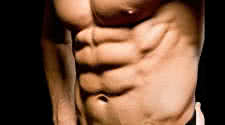Reps & Ab Training - Add Resistance to Build a Stronger Midsection

Knowledge is Priceless when it comes to Fitness Success
When it comes to ah training, don't forgo common sense and basic training techniques for inappropriate methods of
muscle development. The abdominal muscles are no different than other skeletal muscles, so the same principles you
use to build muscle elsewhere should be used to develop a strong midsection. This goes for rep ranges as well as
frequency of your workouts, too.
Along with the muscles of the lower back, the abdominals serve as postural muscles for standing and moving. They
contract frequently and must remain contracted for extended periods, suggesting that they're designed for
endurance activities. Research has confirmed this, showing that the abdominal muscles are generally composed of a
greater percentage of endurance fibers than power fibers.' This "endurance" factor warrants abdominal training
that incorporates a higher number of repetitions. Fifteen or even 20 reps of a given ah exercise is acceptable,
but if you can do more than that, it's time to add resistance.
If you simply desire a firm, toned midsection, you don't need to limit the number of reps. If you're seeking
strength and mass, however, resistance must be continually increased to force the muscle to fatigue within a finite
number of reps. Take the biceps curl as an example: You could do sets of 50 reps with a light weight, resulting in
toned biceps with good endurance properties, but the muscles wouldn't be very strong and would gain very little size.
The same is true for the abdominals. To develop strength and mass, an appropriate resistance must be used to
adequately stress the muscle and stimulate growth.
Yet you can increase the stress on the muscle without adding resistance. One way is to slow the motion, pausing at
the end of the movement to maximally hold the contraction. Maintaining constant tension in the muscle by not resting
at the top or bottom and using a controlled pace throughout the range of motion can have a similar effect. Both
techniques, alone or together, will increase the intensity without increasing resistance. But to really build mass,
you'll likely have to add resistance to your ab training eventually.
Care must be taken when training abs - the obliques in particular - to avoid excessive mass and overdevelopment. A
toned and muscled midsection is the focal point of a shapely and symmetrical physique. On the other hand, a massive
and bulky abdomen makes the waist look wider, erasing the "V" taper and creating the illusion of narrow shoulders.
Once you've laid a decent foundation of hard abdominal muscle, consider switching to a maintenance routine by
reducing the frequency and intensity of your ah training. This is what many top bodybuilders do, which is why they
can get by with little or no ab work at all.
Whatever you do, don't throw basic bodybuilding principles out the window just because you're training abs. The same
techniques that build massive bi's and thighs will lead to the development of a strong, rippled midsection.